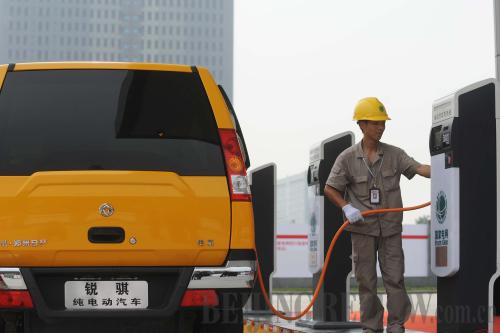|
 |
|
CHARGING CONVENIENCE: The first charging station in Sichuan Province is launched in Chengdu on May 28. National Grid plans to build more than three charging stations and more than 300 charging poles in Sichuan by the end of 2010 (JIANG HONGJING) |
While it remains to be seen what kind of progress will be made following the UN Climate Conference in Cancun, Mexico, one thing is certain: China is taking great strides to honor its emission reduction commitments.
Already, the country has beefed up energy conservation, environmental protection and new-energy development. Targets have been outlined, measures adopted and favorable policies enacted—these, while winning international recognition, have allowed China to gain a foothold in the global low-carbon race.
And China, already the world's largest automaker as of 2009, now looks to overtake developed countries in producing new-energy vehicles.
New-energy vehicles were listed as one of China's strategically important emerging industries during the 12th Five-Year Plan period (2011-15), and the subsequent plan for the auto industry also makes developing new-energy vehicles the industry's top priority. The plan also proposes selling 1 million new-energy vehicles by 2015.
The Ministry of Industry and Information Technology (MIIT) will soon announce a roadmap for energy-efficient and new-energy vehicle industries for the next decade. China will invest more than 100 billion yuan ($15 billion) in forging a complete industrial chain for new-energy vehicle development and make itself the world's largest producer of such vehicles within 10 years.
"China's new-energy vehicle market will progress at full speed, and as a key component to upgrading the industry will provide a reliable guarantee that China fulfill its emission reduction targets in the next 10 to 15 years," said Lu Xi, Deputy Director of the Industrial Policy Department of the MIIT.
On the consumer front, Beijing won approval on November 24 to launch a scheme of subsidizing individual purchasers of plug-in hybrids or all-electric cars, in efforts to realize sales of 30,000 new-energy vehicles by 2012. To facilitate sales, Beijing will build 36,000 charging poles and 100 fast-charging stations in the next two years.
This has made Beijing the sixth Chinese city to launch similar schemes. More cities such as Chongqing and Wuhan will likely join the campaign.
Despite all these favorable policies and tempting subsidies, the sales of new-energy vehicles nationwide, however, are not that encouraging. For instance, only Shenzhen-based BYD Auto and Hangzhou-based Zotye Auto have sold one all-electric car each to individual buyers, and several hundred to corporate or utility buyers.
"Auto makers, industrial associations, as well as the government have to overcome a number of obstacles in order to make new-energy vehicles a popular choice for average Chinese consumers," said Luo Lei, Vice Secretary General of the China Automobile Dealers Association.
Roadmap for the future
According to the ambitious roadmap for China's new-energy vehicle sector, China will strive to become the world's top new-energy vehicle player in terms of its industrial output and market size by 2020.
While China should have 5 million new-energy vehicles by then, the country will also have an annual production and sales volume of 15 million energy-efficient vehicles, mainly micro-hybrids.
The new-energy vehicle as defined in the roadmap mainly refers to all-electric cars, including plug-in hybrids that use an internal combustion engine to charge the battery as a range-extender, fuel cell vehicles and other alternative fuel vehicles, said Ye Shengji, Associate Secretary General of the China Association of Automobile Manufacturers.
"While all-electric cars and plug-in hybrids are two options for China's new-energy vehicle development, we'll also promote micro-hybrid technologies in order to boost energy efficiency of fossil fuel vehicles," Ye said.
Fuel consumption per 100 km by new passenger cars will be cut to 5.9 liters with more than 500,000 new-energy vehicles by 2015, and to 4.5 liters by 2020.
"A total of 500,000 new-energy vehicles will account for about 2.5 percent of China's total auto possession by 2015. That means hybrid technologies will still be widely applied in order to effectively cut auto fuel consumption," said Ye.
The roadmap proposes to invest 50 billion yuan ($7.5 billion) in establishing a special fund for research and development and commercial use of key technologies, 30 billion yuan ($4.5 billion) in related demonstration and promotion efforts, and 20 billion yuan ($3 billion) in promoting micro-hybrid vehicles.
Promoting new energy
In the absence of a convenient charging facility network, major electric-car makers such as BYD, Chery and Zotye have all set out to raise consumer awareness to their electric cars or plug-in hybrids through cooperation with taxi and bus companies or leasing programs.
| 